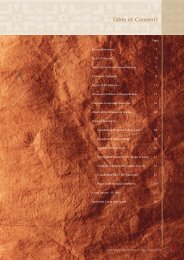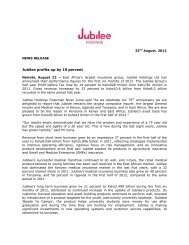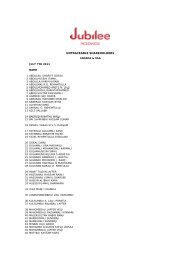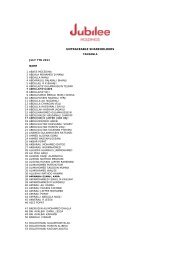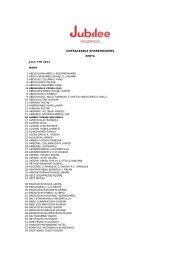Jubilee Insurance 2010 Annual Report
Jubilee Insurance 2010 Annual Report
Jubilee Insurance 2010 Annual Report
Create successful ePaper yourself
Turn your PDF publications into a flip-book with our unique Google optimized e-Paper software.
JUBILEE HOLDINGS<br />
ANNUAL REPORT AND FINANCIAL STATEMENTS<br />
FOR THE YEAR ENDED 31 ST DECEMBER <strong>2010</strong><br />
33<br />
NOTES (continued)<br />
4. Management of <strong>Insurance</strong> and Financial Risk (continued)<br />
Receivables arising out of direct insurance and re-insurance arrangements are summarised as follows:<br />
Group<br />
<strong>2010</strong> 2009<br />
Direct <strong>Insurance</strong> Kshs ‘000 Kshs ‘000<br />
Neither past due nor impaired 634,089 454,738<br />
Past due but not impaired 616,356 549,424<br />
Impaired 168,866 222,928<br />
Gross 1,419,311 1,227,090<br />
Less: allowance for impairment (214,638) (193,392)<br />
Net 1,204,673 1,033,698<br />
Re-insurance<br />
Neither past due nor impaired 95,719 70,817<br />
Past due but not impaired 662,992 317,700<br />
Impaired 140,671 303,012<br />
Gross 899,382 691,529<br />
Less: allowance for impairment (10,625) (8,003)<br />
Net 888,757 683,526<br />
Receivables arising out of direct insurance arrangements past due but not impaired;<br />
Group<br />
<strong>2010</strong> 2009<br />
Past due but not impaired: Kshs ‘000 Kshs ‘000<br />
- by up to 30 days 320,167 148,924<br />
- by 31 to 60 days 78,377 101,710<br />
- by 61 to 150 days 144,885 139,276<br />
- by 151 to 360 days 72,927 159,514<br />
Total past due but not impaired 616,356 549,424<br />
All receivables past due by more than 360 days are considered to be impaired, and are carried at their estimated recoverable value. No collateral is<br />
held in respect of receivables arising out of direct or reinsurance arrangements.<br />
Receivables arising out of direct insurance arrangements individually impaired<br />
Of the total gross amount of impaired receivables, the following amounts have been individually assessed:<br />
Direct insurance arrangements<br />
Group<br />
<strong>2010</strong> 2009<br />
Individually assessed impaired receivables Kshs ‘000 Kshs ‘000<br />
- brokers 91,706 118,274<br />
- agents 21,317 52,686<br />
- insurance companies 25,727 39,918<br />
- direct clients 30,116 12,051<br />
Total 168,866 222,929<br />
Liquidity risk<br />
Liquidity risk is the risk that the Group is unable to meet its payment obligations associated with its financial liabilities as they fall due and to replace<br />
funds when they are withdrawn.<br />
The Group is exposed to daily calls on its available cash for claims settlement and other administration expenses. The Group does not maintain cash<br />
resources to meet all of these needs as experience shows that a minimum level of reinvestment of maturing funds can be predicted with a high level<br />
of certainty. The Board sets limits on the minimum level of bank overdraft facilities that should be in place to cover expenditure at unexpected levels of<br />
demand.<br />
The fair value of financial instruments traded in active markets is based on quoted market prices at the balance sheet date. A market is regarded as<br />
active if quoted prices are readily and regularly available from an exchange, dealer, broker, industry group, pricing service, or regulatory agency,<br />
and those prices represent actual and regularly occurring market transactions on an arm’s length basis. The quoted market price used for financial<br />
assets held by the group is the current bid price. These instruments are included in level 1. Instruments included in level 1 comprise primarily NSE<br />
equity investments classified as trading securities or available-for-sale. The fair value of financial instruments that are not traded in an active market<br />
(for example, over-the-counter derivatives) is determined by using valuation techniques. These valuation techniques maximise the use of observable<br />
market data where it is available and rely as little as possible on entity specific estimates. If all significant inputs required to fair value an instrument<br />
are observable, the instrument is included in level 2. If one or more of the significant inputs is not based on observable market data, the instrument<br />
is included in level 3.<br />
JUBILEE HOLDINGS




